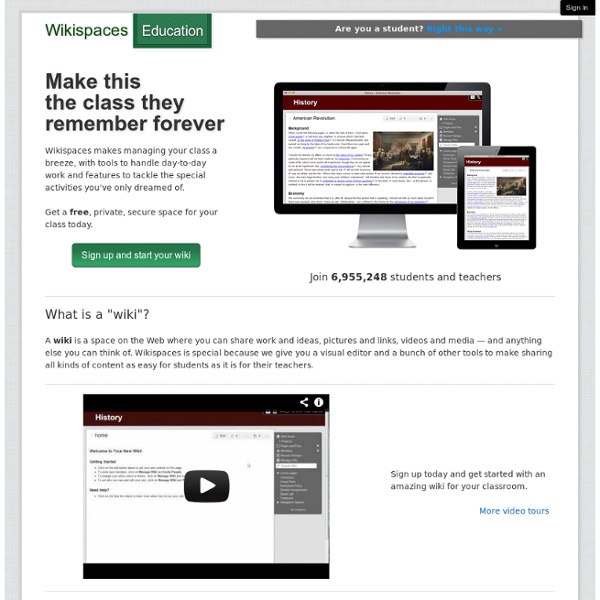



http://www.wikispaces.com/content/teacher
blog - Social Networking For Schools Ever since Skype was sold by eBay in 2009 and its visibility skyrocketed, it’s become an increasingly popular tool in the classroom. In fact, so many tech-savvy teachers have been using it that Skype has recently developed a tool specifically for teachers and their classrooms. The program, called “Skype in the classroom”, was just released from its beta status and has begun to permeate the classrooms of more than 30,000 teachers around the world.
0. Induction: activities This first week is an opportunity to get to grips with how the ocTEL course works and gives everyone the chance to think about some big questions in technology, learning and teaching. We will be touching on several of the issues that will come up in more detail later in the course, but dealing with them in the concrete, practical terms of what you need and prefer as participants, andhow this kind of Technology Enhanced Learning is suited to meeting those needs. This course lets you define your own aims and follow your own paths, but we set out core learning outcomes for every week. By the end of this week, you should aim to
Why (And How) You Should Create A Personal Learning Network What Is A PLN? Through the use of my own Personal Learning Network (PLN) , I came across several great examples that both define what a PLN is, and explain the value of creating one for yourself. According to a wikispace about creating PLNs, “Personal Learning Networks are systems that help learners take control of and manage their own learning. This includes providing support for learners to: 1) set their own learning goals
7 Things You Should Know About MOOCs A massively open online course (MOOC) is a model for delivering learning content online to virtually any person—and as many of them—who wants to take the course. Course activities can be scheduled or asynchronous, and a fluid structure is valuable because students can choose their level of participation and many will do so in an à la carte manner. A MOOC throws open the doors of a course and invites anyone to enter, resulting in a new learning dynamic. Although this dynamic will make some students uneasy and will force instructors to rethink at least some of the elements of their courses, the MOOC can potentially alter the relationship between learner and instructor and between academe and the wider community.
How to Create a Robust and Meaningful Personal Learning Network [PLN] This post describes how educators can develop a personal learning network that supports meaningful and relevant learning. The MOOC, Education Technology & Media, etmooc, is used here as a working example of how to develop a PLN. “My Personal Learning Network is the key to keeping me up-to-date with all the changes that are happening in education and how technology can best support and engage today’s students.” Brian Metcalfe: teacher, blogger at lifelonglearners.com A visual image of participants in an open, online course- etmooc, which shows the potential to find and create personal connections as part of one’s PLN.
educators - Project RED As an in-the-trenches educator, you see the vast potential for technology in the classroom. But how do you help your school and district embrace the full spectrum of possibilities to ensure a successful implementation? Project RED offers tools and resources to support your needs. Project RED conducted the first and only national research study focusing on academic and financial benefits of educational technology. Our research of 1,000 schools revealed key findings for the effective integration of technology in schools-- findings that show a replicable design for reducing costs and increasing student achievement. Let us show you how technology can effectively benefit all students.
The PLP model: Research-based professional learning A vast body of literature underlies the connected learning communities model — our three-pronged approach at Powerful Learning Practice. Here we cite the studies and literature most relevant to connected learning in the digital age and offer supporting points to help readers understand the rationale behind the PLP learning model here. We’ve grouped the findings under three headings — the three components of connected learning communities: professional learning communities (PLCs), personal learning networks (PLNs), and communities of practice (CoPs). After a brief description of each component’s characteristics, we delve into underlying theories, experience and knowledge, effectiveness for teacher professional development, anticipated growth or decline, challenges and dilemmas, and use of technology.
50 Must-See Blogs For Special Education Teachers While being a teacher is never easy, working with students in special education comes with some unique challenges. From writing lengthy IEPs to working closely with parents and other teachers, it takes a calm, collected, organized, confident, and very special person to work with students who often need a great deal more support and assistance than their peers to succeed. Yet even the best special education teachers can use a little guidance, inspiration, and information to help them to be even better at what they do. That’s just what the 50 blogs we’ve collected here can do. Special Education Teaching Tips and Strategies These blogs are written by teachers and educational professionals who share their ideas, tips, tools, and advice for working with special education students.
Operant Conditioning - Free Intro to Psychology Video Last revised: March, 2014 Acceptance of Terms Please read this Terms of Service Agreement ("Terms of Service", "Terms of Use") carefully.